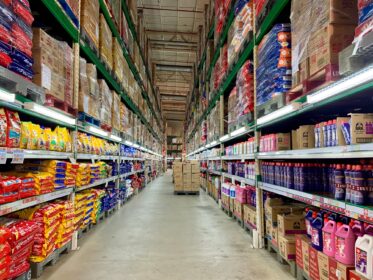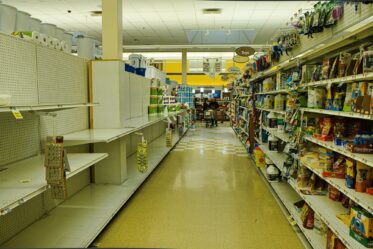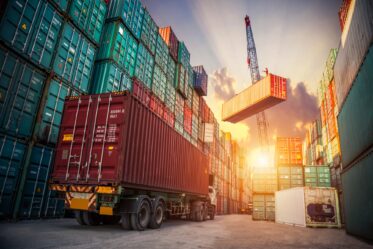
COVID-19 has ruthlessly exposed many of the long-standing vulnerabilities in global supply chain systems, prompting some companies to radically rethink their business models and processes.
Those agile enough seized the moment and have prised open new growth opportunities. Ultimately, as Deloitte notes, “It has demonstrated the power of interconnected, digital supply networks (DSNs) to enable organizations to anticipate, sense, and respond to unexpected changes and minimize their impacts.”
CNN Business reports – citing data from IRI, which tracks in-stock levels at US grocery chains, big box stores, pharmacies, and wholesale clubs – that for the week ending 3 October, around 18% of beverages, 15% of frozen foods, 16% of snacks, 15% of candy, and 18% of bakery items were out of stock at stores.
Global shortages can directly be attributed to a combination of material, component, and labor shortages, disruptions in global supply chains, and pandemic-driven demand. And pressure is mounting on businesses to ensure shelves are stocked. Pandemic-induced port lockdowns are also impacting overall shipping capacity and deliverability.
While the long-term effects of the pandemic are still being debated, the COVID-19 crisis has served as the catalyst for seismic shifts in what consumers value, and how they buy. For businesses, it has underlined the need for them to adapt and innovate to meet customer demands and earn their trust and loyalty in the process.
Beyond the immediate economic and operational concerns of the pandemic, how might supply networks in a post-pandemic world shape up? Smart and careful planning blended with a thorough understanding of the current supply chain climate are the ingredients needed to successfully navigate the challenges playing out in the current climate… and there are many.
How is the labor shortage impacting the supply chain?
“The worker shortage is real – and it’s getting worse by the day,” noted US Chamber of Commerce President and CEO Suzanne Clark
In the current economic climate, the number one challenge facing businesses is finding qualified workers. Without enough employees, businesses are forced to turn down potentially lucrative jobs, slash working hours, scale back vital operations, or worse, roll down the shutters permanently.
Recently at the Port of Los Angeles, the biggest in the US, there weren’t enough workers to unload goods from ships, triggering shipping delays and angst across the United States. In September, on one day, a record 73 ships could not unload goods because of a shortage of workers. Before COVID-19, it was unusual for more than one to have to wait at a time.
Earlier this year, the Biden administration set up a Supply Chains Task Force and appointed a Port Envoy to find solutions for the disruptions in LA and elsewhere. In October, it was announced that LA Port will start operating 24/7 in an attempt to break the backlog.
In the hustle and bustle of the retail world, firms already pummeled by the labor shortage are desperately deploying innovative ways to entice new recruits. Amazon in the UK, for example, recently advertised a £1,000 signing bonus for warehouse pickers and packers to meet the rapidly increasing online shopping demands. Their generous offer did not end there. New recruits were also offered a lucrative hourly rate of £11.10 and £22.20 an hour for overtime. Other UK companies like grocery giants Tesco and Asda are following suit, offering similar incentives to truck drivers.
In South Africa, Union Tiles, one of the country’s biggest tile merchants, reported that apart from frustrations over international product lines being unloaded, they’re also experiencing severe inter-province delays. An official said they‘ve been waiting for “months” for around 60 containers stuck at Durban Port to be loaded and transported to their Johannesburg base.
The most obvious consequence of these staff shortages is an ever-increasing delay in the supply chain. Companies are struggling to fill and process orders, while customers wait extended periods for their goods to arrive.
Delivery is not the only area affected by these challenges, though. Shoppers are faced with increasing product shortages on shelves. Companies like Costco have reinstated purchase limits on toilet paper, paper towels, bottled water and other high-demand cleaning products.
Shortages at production centers compound challenges
Yes, the pandemic, the lockdowns, and the restrictions have stretched supply chain capabilities to near breaking point, but they also served to highlight the supply chain weaknesses within specific sectors. A sobering Agri Pulse report, covering the last 14 months, gives clear insight into the strain on the supply chain.
About 67% of the active ingredients of herbicides, 43% of insecticides, and 20% of fungicides all come from one source: China. What this means is countries do not even need to suffer a disaster for their supply chains to be disrupted. This is a perfect example of how a supply chain interruption thousands of miles away can affect local markets. Importantly, it highlights the need to look at spreading supply across regions to minimize this type of risk.
A global perspective on challenges faced
Countries across the globe continue to experience issues with both grown products and those synthesized from raw materials. Let’s take chicken products in the US, for example. The industry recorded single-digit dips during Q1 2021 due to increased demand and a reduced supply.
Here, the supply chain strain from the pandemic was exacerbated by other factors. These included the heavy winter storms that lashed Texas and surrounding states – all major chicken-producing regions. This resulted in a lack of food availability in restaurants across the county. Dining establishments had to scramble to change menu items and remove chicken dishes from their offerings.
In another case, South Africa faced similar shortages earlier in 2021, but these were spurred by two different drivers. Unprecedented violence and unrest in parts of the country saw warehouses, shops, and factories stripped in a looting frenzy. This crippled the supply chain throughout the country for weeks, with the effects still being felt as customers and distribution centers wait months for supplies to arrive. This was preceded by egg shortages across the country brought on by a strain of bird flu affecting chicken farms in the country’s northern regions.
What the global 2021 supply chain change looked like
Under-pressure businesses scrambled to ease global supply issues in the run-up to Christmas. With economies opening up, consumer demand roaring back, and retailers rushing to replenish inventories, already disrupted global supply chains struggled – and continue to struggle – to keep pace.
Professor Tao Lu, who studies supply chain management and transportation logistics at the University of Connecticut says shortages of virtually every type of product are becoming apparent on American shelves. “Home furnishings, electronics, seasonal clothing, and toys are all on the grab-them-if-you-want-them list,” Lu told the university’s in-house publication recently.
These across-the-board bottlenecks, he says, seem to be caused by goods being stuck in transit, especially due to congestion at ports and other delivery challenges. Lu adds that it’s a phenomenon not unique to the US. It is playing out in ports around the world, impacting directly on supply chain turnaround times. Nike, for instance, is reporting delivery challenges that see it taking upwards of 80 days to ship products across continents, something that, in 2019, took half the amount of time.
Supply chain costs are also not untouched by the current climate, with a McKinsey study showing an increase of 600% in shipping costs from 2019, costs that are being borne by businesses along the chain: costs that ultimately impact consumers.
A well-functioning supply chain process requires all links to work efficiently and collaboratively. But as Lu further points out, even though there may be enough dock workers to unload containers, if there are not enough truck drivers to transport the containers, and if there is not adequate warehouse space to store the goods, the whole system is “out of whack.” For businesses, one chink in the link means another rethink.
The impact of the last two years
The instability of the last two years has wreaked havoc on the shipping industry as hard-pressed companies – scrambling to save costs – were forced into culling staff and cutting back on other operational areas. As the world starts to normalize (somewhat) the shipping industry has found itself on the back foot, desperately in need of time to get its operations back up to full speed.
In the US, the White House is on red alert. President Joe Biden is planning the biggest investment in America’s ports in history as part of the $1tn infrastructure bill currently before the Senate. “Our goal is not only to get through this immediate bottleneck but to address the long-standing weaknesses in our transportation supply chain that this pandemic has exposed.”
COVID-19 has further amplified the urgent need for companies to diversify their supply sources beyond a single country or region, as well as understand their broader ecosystems. Supplier diversification has been steadily gaining momentum in recent years, as rising costs and geopolitical fall out from trade wars have spurred organizations to add critical infrastructure in a second, typically lower-cost country, to bolster their existing supply networks.
Biden, it seems, is taking note, adding that he is looking to make it easier for US firms to produce home-grown products. “Never again should we have to rely too heavily on one company or one country or one person in the world.”
Millennials and Generation Z consumers, meanwhile say they are determined to support local businesses and will not hesitate to ditch firms whose stated and practiced values do not align with their own. Furthermore, a 2020 Manufacturer’s Alliance for Productivity and Innovation study found that 74% of manufacturers expect that transparency around environmental, social, and governance (ESG) goals to become essential going forward. This means companies may be compelled to prove their ability to deliver on these commitments, reinforcing the need for transparency and redefining what trust and sustainability will mean in a post-pandemic global supply chain.
The more positive side of this story
It is not all doom and gloom though. Much can be gleaned from some of the steps companies are taking to survive these turbulent times. In a report aimed at supporting distributors and helping them effectively navigate these challenges, McKinsey segmented businesses and highlighted some of the positive measures they are implementing to ensure they remain competitive.
Companies experiencing sharp and unprecedented drops in demand
These include those entities hardest hit by physical distancing and other government-issued directives. Food service distributors fall into this category and the sector has been quick off the mark, introducing new business models that speak to the new realities. A shift from in-store to remote has ushered in new opportunities and has given operators the opportunity to move furloughed employees into new roles… saving jobs and keeping operations running.
Companies experiencing an explosive increase in demand
Firms here include those managing supplies in greatest demand during this time. These range from medical suppliers and safety and cleaning product retailers to videoconferencing tool developers and home entertainment vendors. Some of the more creative measures implemented here include lucrative hiring bonuses and hourly rates. Many have also implemented enhanced COVID-19 protocols in their warehouse spaces to ensure the safety of their workers.
Companies experiencing muted or irregular demand
Possibly the hardest category to manage, companies here (spanning a wide spectrum) are constantly dealing with uncertainty and the need to think on their feet. Demand fluctuates constantly and there is no rhyme or reason to the ever-evolving demands of customers here. A strategy that has proved extremely effective is the move to e-commerce platforms.
What all these initiatives show is that while it’s important to learn from the current supply chain challenges (or is it crises?)… these lessons need to be tempered against current needs, wants, and realities. These solutions are a direct result of companies thinking out of the box, taking bold, calculated risks, determined to find solutions.
How is your business faring with the supply chain frustrations?
Things can change quickly for companies competing on a global scale and not just because of unexpected supply chain fissures caused by the pandemic, but also due to disruptive technologies and sudden market shifts.
Traditionally, supply chain strategy and business strategy have been kept separate. This needs to change, and fast. Fueled by global complexity and the enormous stress placed on networks, companies must begin to challenge the long-held conventions of relying solely on supply chains to meet their commercial needs. If companies want to maintain their edge post-pandemic, supply chain considerations must become integral to business strategy.
Global firms have a lot to consider if they want to keep up or move ahead of the pack. A decade ago, a standard enterprise resource planning, transportation, and inventory solution were all typically sufficient to meet the needs of the market. Technological advancements, however, have completely transformed supply chain management processes. Increasingly, measuring success and failure is now based on data. It’s thus crucial for businesses to determine how data and technology will impact their operational and supply chain objectives.
Skynamo’s solutions provide this type of support and give teams the accessibility to the data they need to make better, more informed decisions. Companies can quickly determine which strategy to implement when the tide turns in the current choppy climate, empowering leaders with complete and real-time oversight of their entire operational chain.
Why Skynamo? Unlike other applications that simply offer mobile access to their software, Skynamo has been developed specifically as an app for mobile devices, which means a superior experience for mobile users and access to all functionality – even offline.
Skynamo is cloud-based. This means no major hardware, infrastructure or technology expertise, or investment is required. You are up and running in minimal time. Skynamo leverages GPS technology to automatically track sales activity to cut down on administrative tasks for sales reps, increase transparency, and compile valuable insights that enable smarter, faster sales decisions.
The heavy administrative burdens can weigh heavily on your crew and can see focus shift from where it ought to be. Balancing workloads and automating some of these tedious tasks helps you align your focus on other key areas. A clever restructure and smart delegation of tasks get all aboard, opening the hatch to more creative solutions.
While there are undoubtedly a series of obstacles ahead for many supply chain operators, those that embrace the new realities, leverage the appropriate tech, and promote interconnection and transparency will ensure a smooth sail in calm waters. Chat with the Skynamo team today, and let’s chart a sustained growth path, together.




